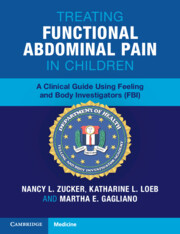 Treating Functional Abdominal Pain in Children
Treating Functional Abdominal Pain in Children from Part I - The Background Science Behind Feeling and Body Investigators
Published online by Cambridge University Press: 18 November 2023
This chapter provides the rationale and background of interoceptive exposure exercises, the body investigations parents and children (and possibly healthcare providers) will perform in each session. The origins of these exercises in the treatment of panic disorder will be reviewed, while introducing key developmental considerations and explaining the importance of an acceptance-based framework. In brief, in the context of panic disorder, interoceptive exposure exercises were intended to provoke a sensation that was feared and to provide new learning that this experience is not dangerous - new learning that competes with prior beliefs of harm or threat. One of the strengths of the FBI approach is that it uses sensations rather than cognitions as a framework for learning. This is essential for children who often do not have access to the content and meaning of their thoughts, or the language to articulate them with insight. As children do not have well-formed beliefs about threats, body exposure investigations are designed to help children learn how smart and trustworthy their bodies are –experiences that may directly contrast with their prior ones of weakness and vulnerability.
To save this book to your Kindle, first ensure [email protected] is added to your Approved Personal Document E-mail List under your Personal Document Settings on the Manage Your Content and Devices page of your Amazon account. Then enter the ‘name’ part of your Kindle email address below. Find out more about saving to your Kindle.
Note you can select to save to either the @free.kindle.com or @kindle.com variations. ‘@free.kindle.com’ emails are free but can only be saved to your device when it is connected to wi-fi. ‘@kindle.com’ emails can be delivered even when you are not connected to wi-fi, but note that service fees apply.
Find out more about the Kindle Personal Document Service.
To save content items to your account, please confirm that you agree to abide by our usage policies. If this is the first time you use this feature, you will be asked to authorise Cambridge Core to connect with your account. Find out more about saving content to Dropbox.
To save content items to your account, please confirm that you agree to abide by our usage policies. If this is the first time you use this feature, you will be asked to authorise Cambridge Core to connect with your account. Find out more about saving content to Google Drive.